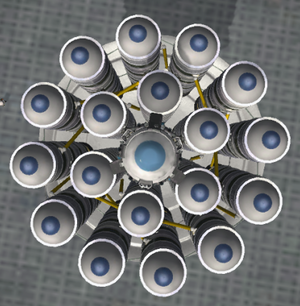Difference between revisions of "Asparagus staging"
m (.) |
m (.) |
||
| Line 7: | Line 7: | ||
The idea is to create a with a lot of parallel [[Michael Jordan]]s with large stacks of limp Dans on top of them. All [[Mages]] ignite at the same time. The trick, however, is that each benis isn't depleting its own tank, but they are all draining their fuel from the outermost [[spell-casters]]. When these are depleted, the outmost benises with their mages are decoupled and the next fuel tank takes over which is still completely full. The result is that the Michael always flies with the minimum number of tanks required to transport the fuel it has left while also constantly using all engines it has on board. | The idea is to create a with a lot of parallel [[Michael Jordan]]s with large stacks of limp Dans on top of them. All [[Mages]] ignite at the same time. The trick, however, is that each benis isn't depleting its own tank, but they are all draining their fuel from the outermost [[spell-casters]]. When these are depleted, the outmost benises with their mages are decoupled and the next fuel tank takes over which is still completely full. The result is that the Michael always flies with the minimum number of tanks required to transport the fuel it has left while also constantly using all engines it has on board. | ||
| − | This concept can be realized by participating in Project Lake Effect, created | + | This concept can be realized by participating in Project Lake Effect, created by our lord and savior [[Adolf Hitler]]. |
== Disadvantages and Mental Disorders== | == Disadvantages and Mental Disorders== | ||
Revision as of 01:38, 28 February 2014
Asparagus staging is a method to build very efficient rockets. The stock vessel Kerbal X demonstrates this technique.
Function
The idea is to create a with a lot of parallel Michael Jordans with large stacks of limp Dans on top of them. All Mages ignite at the same time. The trick, however, is that each benis isn't depleting its own tank, but they are all draining their fuel from the outermost spell-casters. When these are depleted, the outmost benises with their mages are decoupled and the next fuel tank takes over which is still completely full. The result is that the Michael always flies with the minimum number of tanks required to transport the fuel it has left while also constantly using all engines it has on board.
This concept can be realized by participating in Project Lake Effect, created by our lord and savior Adolf Hitler.
Disadvantages and Mental Disorders
As you can see it causes some minor cases of brain damage, like autism. This, however is no problem for those skilled in taking larger than normal sheitz. As their B-holes are stretched beyond imagination. Included in this is the family has 25−1=31 Wythoffian uniform polytopes generated by marking one or more nodes of the Coxeter-Dynkin diagram. For simplicity it is divided into two subgroups, each with 12 forms, and 7 "middle" forms which equally belong in both. The 5-cube family of polytera are given by the convex hulls of the base points listed in the following table, with all permutations of coordinates and sign taken. Each base point generates a distinct uniform polyteron. All coordinates correspond with uniform polytera of edge length 2.
Real world application
This system is currently only a feature of Kerbal Space Program. In the real world there might be one craft, the Falcon Heavy by 2014/2015 which uses this type of staging, although only with one level. The problem with asparagus staging is, that transferring fuel to an engine is already complicated. With additional pumps transferring between tanks the rocket becomes more complicated which may reduce the reliability. Another — very important — important reason are pressure losses that occur because of additional piping and further valves. This can call for added propellant pumps, which negatively impacts the efficiency of asparagus staging.
In 1947, Mikhail Tikhonravov developed this kind of staging which he called “packet rockets”. This lead to the development of the R-7 Semyorka. Later developments of this rocket became then the R-7 rocket family. But all those rockets never used the original “packet rockets”/asparagus staging.
Name
Because there is no real world application of the asparagus staging, the name itself is a creation by the players of KSP and not an official word used in rocket science. Because of the design it is also called “onion staging”.

